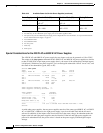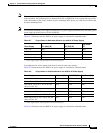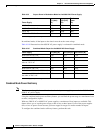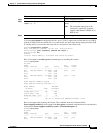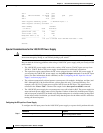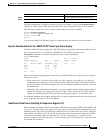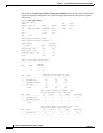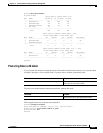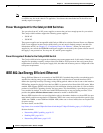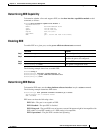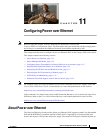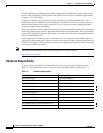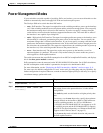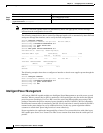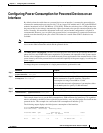
10-22
Software Configuration Guide—Release 15.0(2)SG
OL-23818-01
Chapter 10 Environmental Monitoring and Power Management
IEEE 802.3az Energy Efficient Ethernet
Note After you enter no hw-mod mod x power command and OIR the linecard, the configuration persists and
is valid for any slot in the chassis it is applied to. You observe the same behaviour in the active and
standby supervisor engines.
Power Management for the Catalyst 4948 Switches
You can select from AC or DC power supplies to ensure that you have enough power for your switch.
The Catalyst 4948 switches support the following power supplies:
• 300 W AC
• 300 W DC
These power supplies are incompatible with Catalyst 4500 series switches. Because Power over Ethernet
(PoE) is not supported on the Catalyst 4948 switch, you only need a limited wattage is needed. (For
information on PoE, see Chapter 11, “Configuring Power over Ethernet.”) When you insert power
supplies in your switch, the EEPROM on the power supplies can be read by the system software even if
the supply is not powered on. You may mix AC and DC power supplies.
Power Management Modes for the Catalyst 4948 Switch
The Catalyst 4948 switches support the redundant power management mode. In this mode, if both power
supplies are operating normally, each provides from 20/80 to 45/55 percent of the total system power
requirements at all times. If one power supply fails, the other unit increases power to 100 percent of the
total power requirement.
IEEE 802.3az Energy Efficient Ethernet
Energy Efficient Ethernet is an extension of the IEEE 802.3 standard that provides a mechanism and a
standard for reducing energy usage without reducing the vital function of network interfaces. EEE
defines the signaling necessary for energy savings during periods where no data is sent on the interface.
EEE defines support for physical layer devices (PHYs) to operate in Low Power Idle (LPI) mode. When
enabled, EEE supports QUIET times during low link utilization allowing both sides of a link to disable
portions of each PHY's operating circuitry and save power. This functionality is provided per port and
is not enabled by default. To avoid issues with EEE functionality on any port during run-time, Cisco
provides the power efficient-ethernet auto command to enable or disable EEE.
Because EEE function relies on Auto Negotiation pulse to determine whether to activate EEE, the port
must initially enable auto negotiation. Furthermore, EEE is the correct action provided the speed is auto
100M, auto 1000M, or auto 100M and 1000M. 10M (either auto or forced mode) does not require EEE
for power saving.
For more details, see the URL:
http://www.cisco.com/en/US/prod/collateral/switches/ps5718/ps4324/white_paper_c11-676336.pdf
Sections include:
• Determining EEE Capability, page 10-23
• Enabling EEE, page 10-23
• Determining EEE Status, page 10-23



